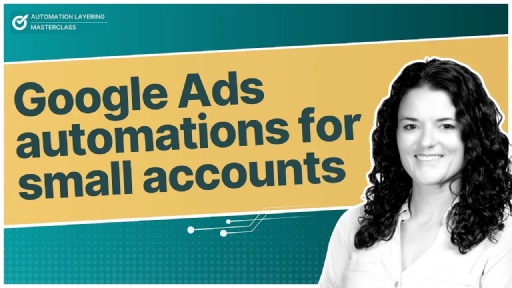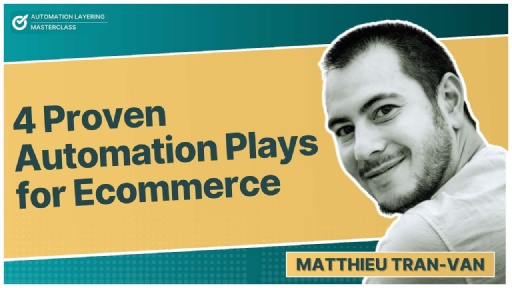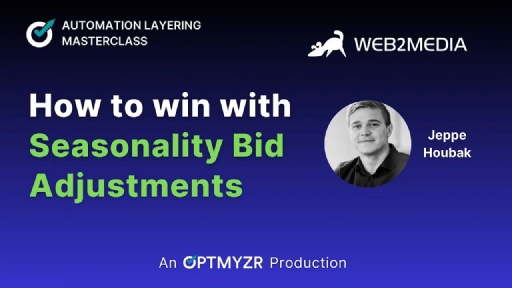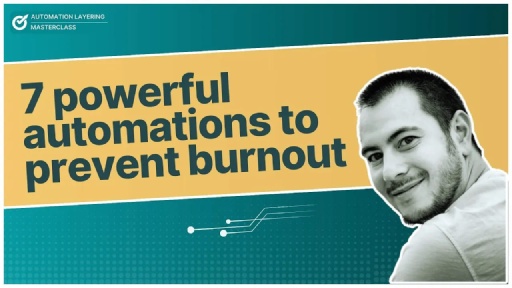
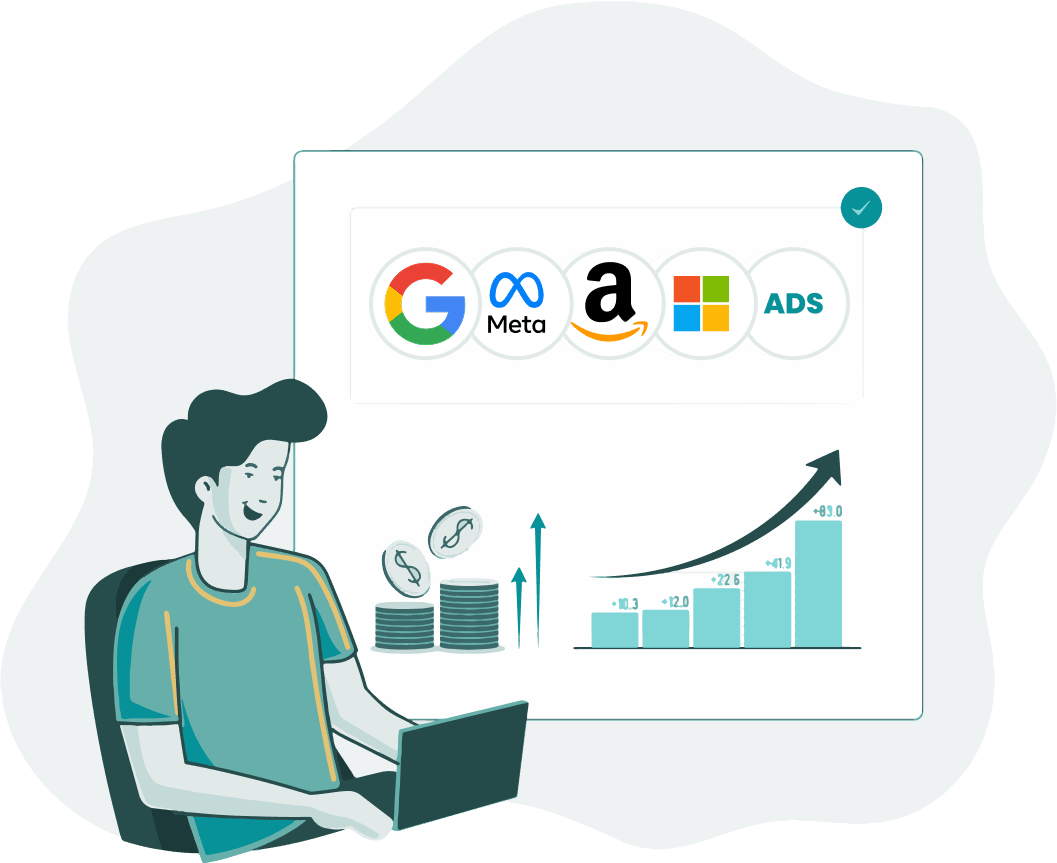
Episode Description
Craig Belcher and Emilie Eidson, a father-daughter duo running EliminateWastedSpend and YourPPCPro share how they use automation layering to manage their clients’ PPC campaigns.
They discuss the use of automation in keyword query management, ad text optimization, and placement analysis. They also emphasize the importance of automation in streamlining campaign management and ensuring high-quality conversions.
Episode Takeaways
Craig and Emilie are proving that automation doesn’t replace human expertise – it enhances it. Through sophisticated automation layering, they’ve developed systems that reduce the mental load on marketers, catch subtle performance issues before they become problems, and even detect fraudulent traffic that standard automation would miss.
Let’s dive into their discussion with Frederick Vallaeys to understand how they deliver significant reuslts to their clients using comprehensive, well-designed systems.
1. How Craig and Emilie leverage automation to reduce cognitive load and ensure consistency
Craig and Emilie use automation to manage PPC accounts so as to dramatically reduce mental load. This is especially important since their agency handles a large number of clients. For instance, automation has significantly changed their approach to query management. Earlier they would manually comb through search term reports, potentially sifting through thousands of queries monthly. ow, they’ve built automation rules that filter queries based on specific criteria (impressions, clicks, conversions) and deliver only the most relevant ones for human review.
“One of the things I love about the automation layering is the fact that we can reduce the mental load on marketers. Back in the day we used to pull manual search term reports every 30 days or so and we would comb through those reports and look for negatives that we could add to the campaigns or potential converting keywords that we could add.
This was very time consuming because depending on this spend you could have you know 500 queries or you know up in the thousands of queries to review. We use a combination of different automations from Optmyzr in order to simplify that management" explains Emilie.
Another way they use automation is to identify gradual performance declines that would be practically be impossible to spot manually across multiple accounts.
2. How to spot fraudulent placements with smarter analysis
Conventional PPC management dictates that placements generating conversions should be automatically added to campaigns. However, Emilie and Craig’s experience led them to question this.
Interestingly, they discovered that there were placements with moderate conversion rates that seemed legitimate at first glance but were actually fraudulent on deeper inspection. So they developed a strategy that was focused on examining the relationship between impressions, clicks, and conversions—not just the conversion rate in isolation. They found that fraudulent placements often have inconsistencies in these metrics that reveal artificial or invalid traffic patterns.
“We have some automations that look at automatic placements in campaigns. We had a rule that sent us placements that we should add because they’re converting and you would think that yes, converting placements should be added to campaigns.
But the impressions and clicks for those specific placements weren’t legit. They’re more than likely fraudulent because they convert but they converted at a rate that slips under the radar” shared Emilie.
So rather than just simply asking “does this placement convert?” they started asking “does the entire traffic pattern for this placement make logical sense?” This is an example of how automation works to surface potential issues while human judgement is used to interpret patterns.
3. Catching CTR declines early in Responsive Search Ads
Emilie and Craig also set up automations to track gradual CTR decline in Responsive Search Ads— something that is easily missed in Google’s native tools.
“It’s one of those things that if you didn’t have the automation set up, you wouldn’t know. You don’t have the time to go in and look at all of the different responsive search ads in a campaign and check to see if the impressions and the clickthrough rates increased over the last 30 days or not for all of the different accounts that you manage.” said Emilie.
Their system specifically monitors responsive search ads for declining click-through rates over a 30-day period. They’re not just looking for dramatic drops (like from 5% to 3%) but rather consistent patterns of small, incremental declines (5% to 4.7% to 4.6%, etc.) that signal a problematic trend. By comparing multi-week performance trends, they proactively refresh ad creatives before significant performance drops.
4. Using automation to provide better client service
Emilie and Craig also leverage automation to provide better client service. By implementing universal automations, they ensure that core management standards are met across all accounts irrespective of the size. Higher-touch clients receive weekly calls, while lower-tier clients benefit from automated monitoring.
This approach supports scalable, profitable client servicing without sacrificing quality.
Episode Transcript
Frederick Vallaeys: Hello and welcome to another episode of Automation Layering Master Class. My name is Fred Vallaeys and I’m CEO and co-founder at Optmyzr and I’m your host for this show. Today we have Craig and Emilie from your PPC Pro. They’ve been using Optmyzr since 2014 and so in all those years that they’ve been using it they’ve certainly figured out all the tips and tricks and we’re super lucky that they decided to join us today to share how they use Optmyzr for automation layering.
So let’s bring in our guests for today.
Alright Emilie and Craig thank you for coming on the show today. So Emilie let’s start with you. Tell us who you are, where you’re calling us from, and what you do.
Emilie Eidson: Yeah, my name is Emilie Eidson. I am a co-founder of EliminateWastedSpend and I’m a page search specialist. It is what I like to call myself.
Frederick Vallaeys: No laughing there right? I mean you’re a PPC expert.
Emilie Eidson: I am calling from Rogersville, Tennesse and I was born and raised in East Tennessee and I ran the EliminateWastedSpend with my father Craig Belcher.
Frederick Vallaeys: Oh wait, Craig is your father? Welcome to the show. So we know you’re Emilie’s dad. What else should we know about you?
Craig Belcher: Actually I mean if you hadn’t noticed us, we are from the Southern United States. So we’re about an hour, if anyone’s been to Gatlinburg, you know Tennessee or Knoxville, Tennessee, we’re about an hour east of there. But we have clients all over the world and we’re actually a family team you know. As Emilie’s already mentioned. I’ve been doing it for, I don’t know how many years it is since 2007.
Frederick Vallaeys: That’s fantastic, so family team! Let’s talk a little bit more about how that started and how you work together.
Craig Belcher: Alright! So I’ll do a really quick spill and then let Emilie jump in. She’s done a lot of the automation and I just ask her to do it and she’ll go in Optmyzr and find it.
But basically we’re a small digital agency focused on family, you know small business and the very first business that I had was actually affiliate program software and I said when I sold that business I was willing to do it the way that I wanted to do it the next time around. And that was spend time with the family you know. I didn’t know it was going to involve hiring family but yeah it’s been a blessing.
Frederick Vallaeys: So I love that story because one of the things about Optmyzr is we really hope to give PPC managers back their time so that they can do something besides work. And if that’s family then that’s family or if it’s your hobbies then its that. But it is very interesting because now hopefully you do have more time thanks to automation layering to you know go home, have family dinners, celebrate together. But then even during the day I guess you’re always working together.
Craig Belcher: Exactly I mean it’s really nice and we’ve actually got the third generation coming up so we’ve got a little two year old that is you know sitting behind the computer right now and you know pretending to be like her mom. Yeah she just sits there and she you know, she pretends like her mommy. So yeah it’s nice but if it wasn’t for Optmyzr, we wouldn’t be able to do this you know.
Frederick Vallaeys: Emilie let’s bsring you into conversation here a little bit as well. So obviously you are Craig’s daughter and I understand that you do a lot of the account management. So talk a little bit about the automation layers that you use and so like let’s let’s maybe start with keywords. Keywords like Craig was saying, have become very “automated” because there’s a big push towards broad match. Google’s matching systems have gotten more sophisticated, but it doesn’t always mean there’s better queries that you’re showing up for. So talk a little bit about maybe the keyword query management that you do.
Emilie Eidson: Back in the day we used to pull manual search uh term reports every 30 days or so and we would comb through those reports and look for negatives that we could add to the campaigns or potential converting keywords that we could add. But this was very time consuming, naturally because depending on this spend you could have, you know 500 queries or you know up in the thousands of queries to review . So we use a combination of different automations from Optmyzr in order to simplify that management.
One of the things I love about the automation layering is the fact that we can reduce the mental load on marketers and we don’t have to worry you know if those keywords are legit or not. We can use a tool like Optmyzr and we can have an email sent with you know queries that have so many Impressions or so many clicks or conversions; however we want to manipulate the rules in order to have those reports sent to us.
We can then review a condensed list of queries that are more relevant. They’re being shown more often, these are the ones that we need to focus on in order to make our changes, our optimizations to the campaigns. So new search queries is one rule that we have and it looks at new queries that have come in the last 30 days with x amount of impressions and then we’ll comb through those and look for potential keywords or search queries that we can add as keywords whether they be negative or positive depending on how we want to proceed
So we also look at close variant as well. That’s an entirely separate report that looks at keywords that are close variants. Ones that Google names as close but maybe they aren’t.
Frederick Vallaeys: Yeah that makes sense. What I love is that you’ve sort of split out query management into buckets and so you said one bucket is - what are the queries that are literally new to us that we haven’t seen in the past and then you have one that might be high converting. And so you break it out and then what you give to the human and your and your team is like okay here’s a watered down list or not a watered down but like a focused list and this is the thing you need to look for in that list. And then you make that final decision and that’s what we’ve always seen. Its that human plus machine outperforms either one by themselves. So I love how you’ve put that together. Now there’s one really interesting thing that I heard that you do which is you actually don’t always like high converting placements. We can talk about that a little.
Emilie Eidson: We have some optimizations or some automations that look at automatic placements in campaigns and we had a rule that sent us placements that we should add because they’re converting and you would think that, yes converting placements should be added to campaigns. However, we found that the conversion rate was moderate so it wasn’t astronomically high. Back in the day when we would add negative placements we would go by really high clickthrough rates. So these conversion rates weren’t really high either. So they slipped under the radar and we found that they shouldn’t be added because the impressions and the clicks for those conversions, those specific placements weren’t legit. They’re more than likely fraudulent because they convert but they converted at a rate that slips under the radar. So if you’re not monitoring those placements, you could add them and the algorithm would teach it to send you more fraudulent traffic.
Frederick Vallaeys: Right. WelL that’s what the fraudesters also depend on right? Like how do we make it look just good enough that you will just put it on the list. So what you found is that there’s sort of that like threshold above or below which it’s like yeah that looks suspicious and so that warrants further investigation as well. So I love that, because again, if you go to a standard automation like you said, it drives conversions, then you should add it and now guess what I mean you’re just like a consistent paycheck to the fraudsters because you’ve added it as a placement. So those placements will continue to appear.
Emilie Eidson: And that’s our whole goal. Its that we want to have that extra layer of protection. So we want to look at those instances that could slip under the radar where we’re spending money that we shouldn’t be spending and how we can cut back to to send more relevant traffic to the client. And maybe we don’t spend their budget an entire month but the quality of the conversions that are coming in are better than what they would have been.
Frederick Vallaeys: I don’t think I’d be upset as a client if you didn’t spend all my money but you still got me the conversions and the leads and high quality ones at that. So that’s great. What about ad text optimization? Is there anything you do there?
Emilie Eidson: We have a couple of different ones. One of them is looking at responsive search ads that have a decline in clickthrough rate and so if the clickthrough rate has declined over the last 30 days then we’ll go in and we will refresh the ad copy in order to potentially increase that clickthrough rate. And it’s one of those things that if you didn’t have the automation set up you wouldn’t know. You don’t have the time to go in and look at all of the different responsive search ads in a campaign and check to see if the the clickthrough rates increased over the last 30 days or not for all of the different accounts that you manage.
Frederick Vallaeys: The other nuance that you’re sort of talking about and I just want to clarify for our viewers is that when you talk about increasing or declining performance of an ad it’s not always just like oh 30 days ago it was at a 5%, today it is at a 3%. It could be those more subtle, gradual declines that take looking at multiple date ranges. So you know four weeks ago it was at 5% and then a week later it was down to like 4.7%, and then it was 4.6%. It’s like a gradual decline. Any period over period it’d be too small to notice but if you look at that longer date cycle and just the consistency of every week, it’s a little bit lower that could be the thing that triggers you know looking at it right. And I think that’s the thing that’s hard to do if you just look at the native Google ads tools but if you bring in your own rules like you’re doing then you can actually say oh this is sort of the level of decline and the consistency of decline that warrants us investigating further. So talk a little bit more about the process and either you, Craig or Emilie but you know you manage a large book of business. How do you sort of like figure out what to do for which account and when?
Emilie Eidson: So I’ll take this one. We have larger clients that we dedicate more one-on-one calls weekly. You know those sort of hands on things but the way that we use the automations in the accounts is pretty much universal because it is looking at things that need to be done regardless of the size of the account. These are you know insurance policies that we have in order to make sure that the campaigns are running smoothly.
So we have ad disapproval notifications. If something has gone wrong and there’s been an ad disapproved whether it was from an issue with a bug within Google that’s caused a mass disapproval or it’s a URL that’s down, it doesn’t matter. We get an email notification that something’s wrong and it needs to be fixed. I’ll make a shameless plug here for a ad extension, add asset feature that we can manipulate rule engine to get those notifications for disapproved assets as well.
Frederick Vallaeys: Yeah that’s great. So you got PPC insurance and basically one thing that we do see with agencies is you go to your clients and you sell them a promise of some level of commitment and management and it sounds like through automation you’re making sure that that base level is met right?And then you can go above and beyond that, but at the very least like you’re saying you can’t just set it and forget it with these accounts you have to monitor them. You have to do the basics right and that’s like you said it’s time consuming.
But you have the right automations in place, the right automation layers that enables you to do it for all the accounts that you have and hopefully double your book of business and keep growing again for that next generation as your team starts growing because you have more children in the family and they all join the business you know. They’ll need some work to do right?
Craig Belcher: Exactly! When an account comes to us, they stay with us you know. We have no problem because they know that their account is being managed and they’re getting these reports. They’re getting these recommendations from us and we’re getting them from Optmyzr. And it just streamlines the whole process. So I mean we’ve got clients that have been with us for over 10 years at the minimum. Some smaller clients have been with us for a lot longer and we’ll actually go through a company transition. Take Fortune 1,000 company. We’ve been with one company that’s been bought and sold three different times you know.
Frederick Vallaeys: So you’ve been with the company longer than anyone at the company.
Craig Belcher: Exactly. Its pretty cool that they know that the account is being managed to the best of our ability.
Frederick Vallaeys: It is very valuable for your team to keep up with all the changes and with Optmyzr I know that many of these changes are covered because it is hard and it does take an investment from an in-house team to put that in place.
I mean lots of happy customers and if somebody wants to become the next happy customer where do they find you?
Craig Belcher: Actually we are on LinkedIn and we’re also starting a smaller service. So we turn down so many clients because we simply do not have enough man hours to manage them. So we actually have created a smaller solution for at least the mom and pops if they’re wanting to advertise. Its called Eliminate Wasted Spend. Basically we’re going to give them a set of money-saving optimizations that will at least be focusing their budget on where it needs to be focused. But we really feel passionate about the small business. That was one of the reasons why I started the business. The larger companies, they have payroll. They have people and their own in-house talent as well. But the smaller businesses, they don’t have a chance. If they don’t have someone looking out for them their budget is going to be eaten up.
Frederick Vallaeys: I feel like we could have a whole discussion here because you’ve been in the space so long as have I. But the whole premise of adwords back in the day was oh it’s the small business exactly. Oh everybody noticed and the people with the deep pockets and you know they came in and they were like okay now we’re owning this space. And it’s really difficult like you said for a small business to come in and Google, honestly I think to their credit they do make it easier.
Listen if you were eCommerce and you had no clue you were mismanaging a shopping campaign well then PMax is a godsend. Like all of a sudden you can actually compete. But there’s still like that’s why I wrote my book Unlevel the Playing Field. It’s like Google has leveled it but like let’s dip it back into favor of people who are like the experts, who want to put the time in there are ways to do it. And that’s what we’re talking about here, it is automation layering and just making sure that it’s the consistency of managing the account, it’s consistently looking at the right things, it’s evolving your rules. You might start with a simple rule of this is how we look at what’s a good placement but then you’ve become very sophisticated because you look at it and say oh well this is an indicator of fraud so we need to build that in and you automate that next level. And now someone else comes in and there’s a big gap because you’re so far ahead, it’s hard to to catch up.
Craig Belcher: It’s fun. I mean it it keeps you on your toes. It’s challenging and working with companies like yours, it’s fun, it’s rewarding.
Frederick Vallaeys: Yeah. Well hey thank you for being such a longtime customer and thank you for all the great work you do for your clients as well. Thank you so much Emilie and Craig for sharing all of that.
So if you want to work with them then Eliminate Wasted Spend — Saving You More Than You Pay Us is their new effort. Its also Your PPC Pro. Check them out and they’re both on LinkedIn. So connect with them. They’re clearly very happy to share the expertise they have in the PPC industry. They’re great to connect.
If you want to see what Optmyzr is all about, we have a two week free trial. So go and check that out at Optmyzr.com. But Craig and Emilie thank you so much for joining us today.

